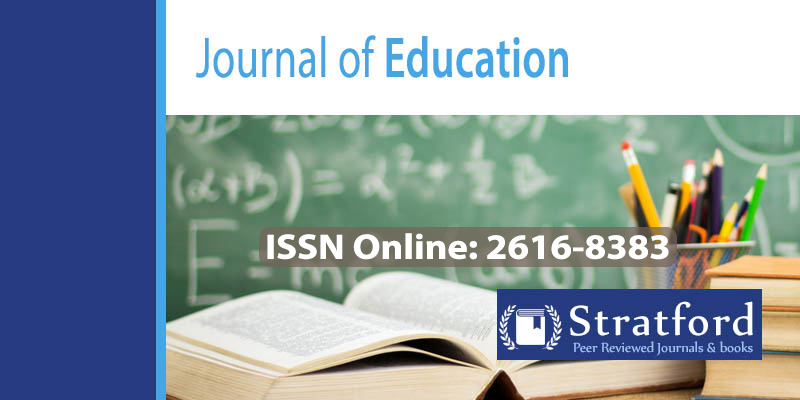Relationship between Teachers’ Competency Level in Teaching English Language and Students’ English Language Proficiency in Secondary Schools in Rwanda
DOI:
https://doi.org/10.53819/81018102t5030Abstract
The improvement of students’ English proficiency depends on the level of teaching English language and the competency of teachers in teaching career. The purpose of this study therefore, was to investigate the relationship between teachers’ competency in English language and students’ English language proficiency within secondary schools of Karongi in Rwanda. The study adopted correlation research design research design. Data collection tools were questionnaire and interview guide. The target population was 1794 people comprised of 1560 students, 14 Sector Education Officers, 20 Head Teachers, 200 teachers. A simple random sampling and purposive sampling techniques were used to get a sample size of 395 respondents. The study findings revealed that majority of the students with a total of 290 (91.2%) agreed that in their school, teachers are not competent enough in English language. Moreover, almost 292 (91.8%) of the respondents agreed that in their school, students English reading, writing, listening and speaking proficiency level is low and 70 (90.9%) of key informants agreed that both in public and private secondary schools of Karongi District, students’ English language proficiency level in reading, writing, speaking and listening is low. The correlation results showed the association between between teachers’ inability to teach in English, teachers’ inability to read classroom interactions in English language, teachers’ incompetency in English language, teachers’ inability to express themselves in English language as well as teachers’ inability to develop English language educational materials) and dependent variables (students’ reading, writing, speaking and listening English language proficiency and students’ English language proficiency (reading, writing, speaking and listening English proficiency) is positive. The study recommended the Ministry of Education through Rwanda Basic Education Board to avail enough English teaching and learning materials, including charts, textbooks and dictionaries which are adequate in enhancing English language proficiency mastery among students at an early age. All stakeholders of the education sector are recommended to support English teaching and learning activities in Rwanda, as it is the only and one shortcut for making Rwandans master the English language.
Keywords: Teachers’ competency, English Language, English proficiency, Rwanda
References
Abbasi, M. G., Ahmad, A., & Khattak, Z. I. (2010). Negative influence of large scale. Cambridge: Cambridge University Press.
Abdirahman M. Addow, Abdullahi Hussein Abubakar, Mohamed Said Abukar.( 2013) English language Proficiency and Academic Achievement for Undergraduate Students in Somalia. Available at http://www.erint.savap.org.pk/pdf/vol.2(2)/Erint. (2.208).pdf, accessed on 28/ Feb, 2014.
Ambridge, B., & Lieven, E.V.M. (2011). Language Acquisition: Contrasting theoretical approaches. Cambridge: Cambridge University Press.
Amitava R (2010). Factors affecting Student’s academic performance: A case study in Agartala Municipal Council Area. Bangladesh e-Journal Sociol. 7(2)
Chomsky, N. (1975). Reflections of Language. New York: Pantheon Books. https://doi.org/10.21236/AD0616323
Department for international development DFID. (2005). Girls ‘education: towards a better future for all. UK
Driscoll, D. P. English language Proficiency Benchmarks and Outcomes for English language Learners. The Commonwealth of Massachusetts, Department of Education. 2006
Frankel, R.J. & Warren, N.E. (2006). How to Design and evaluate Research in Education? (6th Ed). New York: McGraw Hill.
Gardner. R. C, Eurosla Yearbook, (2006). The social-educational model of second language acquisition: A research paradigm. https://doi.org/10.1075/eurosla.6.14gar
Kendra A. Palmer (2009). "Understanding Human Language: An In-Depth Exploration of the Human Facility for Language". StudentPulse.com. Retrieved 22 August 2012.
Klaassen, R.G., & De Graaf, E. (2001). Facing innovation: Preparing lecturers for English -Medium Instruction in a non-native context. European Journal of Engineering Education, 26, 281-289. https://doi.org/10.1080/03043790110054409
Lynd M. (2010). Assessment report and project for an education strategy (USAID/Rwanda report). Retrieved from http://pdf.usaid.gov/pdf_docs/ PNADY121.pdf
Majyambere, G. (2009). Rwanda: English key in country becoming financial hub. Retrieved from http://allafrica.com/stories/200810220656.html
Ordho, A.J. & Kombo, D.K. (2009). Research Methods, Nairobi: Kenyatta University, Institute of Open Learning.
Pine, J.M., Conti-Ramsden, G., Joseph, K.L., Lieven, E.V.M., & Serratrice, L. (2008). Tense over time: testing the Agreement/Tense Omission Model as an account of the pattern of tense-marking provision in early child English. Journal of Child Language, 35(1): 55-75. https://doi.org/10.1017/S0305000907008252
Republic of Rwanda, Ministry of Education. (2009). Teacher service commission baseline survey. Kigali, Rwanda
Rosendal, T. (2009). Linguistic markets in Rwanda: Language use in advertisements and on signs. Journal of Multilingual and Multicultural Development, 30(1), 19–39. https://doi.org/10.1080/01434630802307882
Rowland, C. F.; & Noble, C. L. (2010). The role of syntactic structure in children’s sentence comprehension: Evidence from the dative. Language Learning and Development, 7(1): 5575. https://doi.org/10.1080/15475441003769411
Samuelson, B. L., & Freedman, S. W. (2010). Language policy, multilingual education and power in Rwanda. Language Policy, 9(3), 191-215. https://doi.org/10.1007/s10993-010-9170-7
Skinner, B.F. (1957). Verbal Behavior. Acton, MA: Copley Publishing Group. Students. https://doi.org/10.1037/11256-000
Theakston, A.L., & Lieven, E.V.M. (2005). The acquisition of auxiliaries BE and HAVE: an elicitation study. Journal of Child Language, 32(2): 587-616. https://doi.org/10.1017/S0305000905006872
Wilkinson L, Silliman E (2008). Academic language proficiency and literacy instruction in urban settings. In L. Wilkinson, L. Morrow, & V. Chou (eds.), Improving Literacy Achievement in Urban Schools. Critical Elements in Teacher Preparation, Newark, DL: International Reading Association
Wilson J, Komba SC (2012). The Link Between teachers and English language Proficiency: A Pedagogical Perspective in Tanzanian secondary schools. World J. Eng. Lang. https://doi.org/10.5430/wjel.v2n4p1
Zangani E, Maleki A (2007). A Survey on the Relationship between English Language Proficiency and the Academic Achievement of Iranian EFL Students. Asian EFL J. 9(1).


